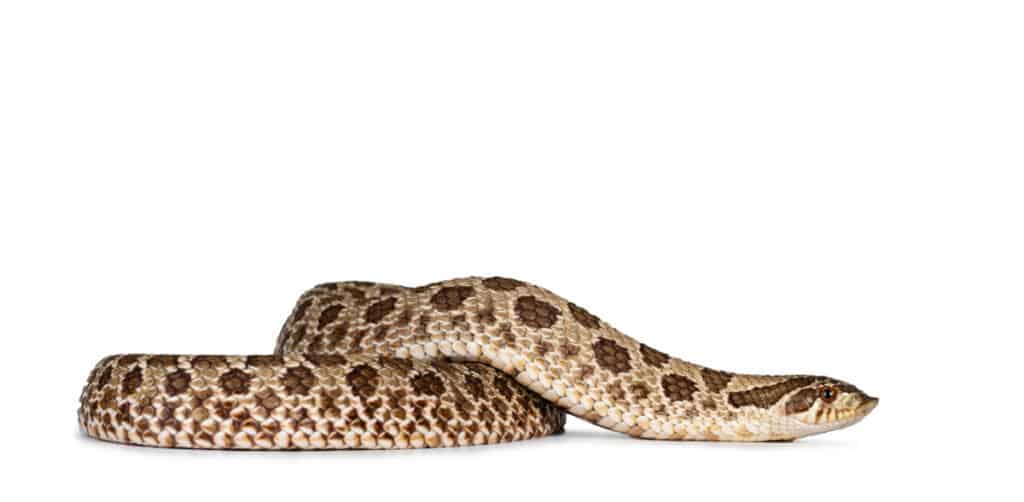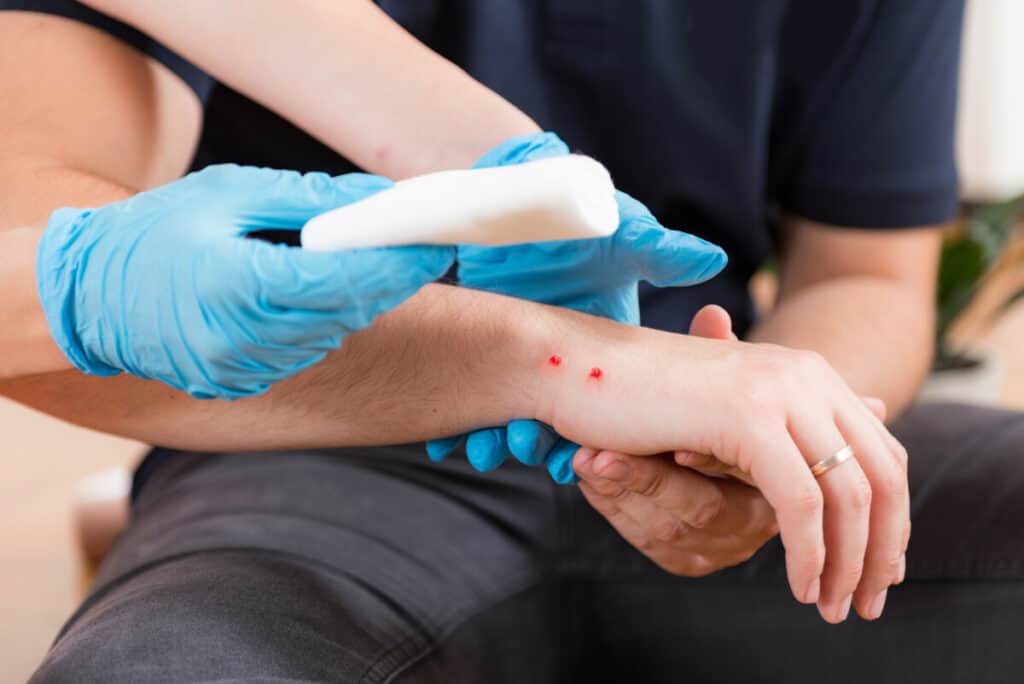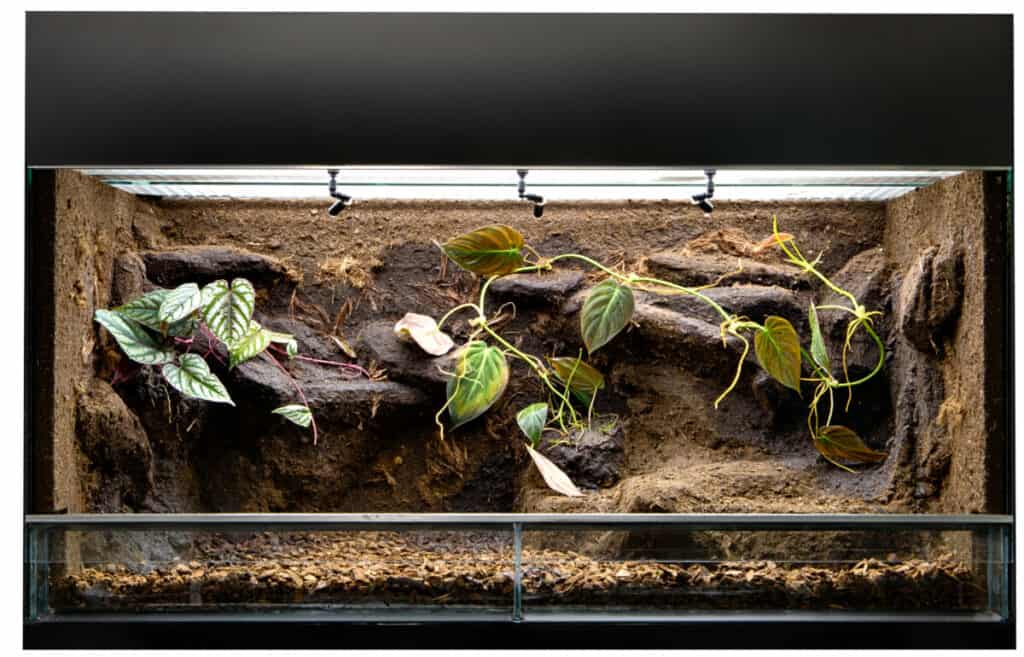
Looking to care for a western hognose snake? Wondering if such a creature is safe enough to keep as a pet? Well, in this article, we will address these very questions. Particularly, are Western Hognose snakes venomous or poisonous?
The North American hognose snake is a mildly venomous reptile whose bite is not dangerous enough to harm a human being. This kind of snake is safe to own because its bite is only venomous enough to harm any animal small enough to be its prey. If bitten by this snake, pour mint mouthwash on the bite.
Though the Western Hognose snake may be mildly venomous, it is not something to worry about. In fact, they are one of the best snakes you can own as a pet.
Hognose Snake Venom
As I mentioned earlier, the hognose snake is mildly venomous. This, of course, means that the snake does, in fact, inject a harmful material into the bite victim. However, not all creatures larger than the snake itself will be greatly affected if they ever happen to be bitten.
When in the wild, the hognose snake normally hunts for smaller animals such as toads, frogs, kinks, lizards, rodents, and the eggs of certain animals. The amount of venom injected by a hognose snake bite is only enough to subdue and kill one of these smaller animals.
Should I Panic if Someone is Bitten By My Hognose Snake?

The likelihood of someone getting bitten by one of these more docile creatures is slim. Again, it is slim, not impossible. The only instance that would provoke a hognose snake to bite someone would be if the person handling the snake were to agitate it to the point of aggression.
Obviously, this is not at all recommended. For the most part, this snake is gentle enough to avoid any panic and yet its unique temperament makes it a fun and enjoyable pet to own.
To prevent the snake from becoming irritated or agitated to the point of acting defensively. Please be sure to handle the snake gently when it is in your hands or winding its way around your arms and by moving slowly if you need to move at all.
Of course, this snake can become stressed at times due to nothing in particular that any person has done to it. Like people, this snake will conduct certain defense mechanisms that are mostly harmless due to the perceived nature of any threat they detect — whether real or otherwise.
These harmless mechanisms include giving itself a hooded appearance like a cobra, hissing loudly from the result of inhaling a large amount of air, false strikes to its front and side, and playing dead.
If the snake begins performing these superfluous actions, just know that it is in no way caused by any negative stressors that you or someone else has brought upon it. As it goes through these actions, just leave the snake alone until it has calmed down.
How to Deal With a Hognose Bite
On the slight chance that the hognose snake bites someone, keep in mind just how small of a threat the snake poses. You do not want to cause a panic where there really is no need for one. If the snake is still clamped onto the skin of the person bitten, do not attempt to remove the snake from the punctured flesh by just yanking the snake away.
Doing this will injure the jaw of the snake and probably inflict greater damage to the skin. To convince the snake to release its grip, simply pour a capful of mint mouthwash onto the head of the snake and the area being bitten. This will not harm the snake in any way.
Once the snake is carefully removed, apply soap and water to the bite and have the victim take a Benadryl within an hour of the bite.
Western Hognose Snakes Get Mistaken For More Venomous Snakes
Now, be aware that the hognose snake is mostly harmless to animals larger than itself. Therefore, it has evolved in a way that allows it to take on the appearance of other snakes that are far more venomous and dangerous to larger animals.
If the snake in question has, in fact, been identified as a hognose snake, then you don’t need to worry. The quickest way to identify a snake as a hognose is by observing the shape of the area between the eyes and the mouth.
If the nose of the snake points upward like that of a tiny shovel, then you can instantly tell that it shares the semblance of the snout of a pig and therefore is worthy of the namesake “hognose.” This allows the snake to burrow and hunt when in the wild.
Hognose Snakes Look Like Rattlesnakes
All of the other physical features of the hognose snake come from its adaption of the physical features of other snakes that are known by both man and nature to be dangerous. Such species that are present in the appearance of the hognose snake are those of the rattlesnake and its subspecies such as the Western Diamondback, the Prairie, and the Mojave.
This evolutionary tactic is known as Batesian Mimicry and allows the hognose snake to survive by appearing more dangerous to its potential predators than it actually is. The hognose snake can even shake its tail like a rattlesnake despite having no rattle. It is almost as if the little guy wags his tail like a dog would when excited — making it more ideal for ownership, don’t you think?
Other ways of identifying a hognose snake are the colors and patterns present on its scales. Overall, they usually take on a browner hue with some varying between the colors gray and tan.
Spots and blotches of a lighter hue run down the back of the snake while the underbelly is mostly glossed in black with a few brighter colors intermixed such as white, yellow, or orange. The scales themselves are not smooth like most other reptilian exteriors.
The scales of the hognose snake are keeled, meaning that they are ridged down the center, giving them a rougher feel akin to that of a rattlesnake.
Western Hognose Snakes As Pets
If you are looking to care for a hognose snake, you first need to know just how old the snake is. The age of the snake will help you determine how often you should handle them and how you should feed them. If the snake is but a hatchling, then it needs time to adjust to its initial surroundings.
During this period, it is appropriate to handle the snake only once every few days. Over time, as the snake grows, it can be handled more often as it adjusts to the presence of its owner. Also, you will need to make sure that the snake is an established feeder before you can keep it as a pet.
Ask the breeder if the snake has eaten at least three to four times on its own before you make the purchase. Though I am just covering some basics here you can check out my complete Western Hognose Care Guide Here!
Feeding the Hognose Snake
The simplest diet for the hognose snake should consist mostly of proper sized rodents. When growing, hognose snake might need multiple feeding per week or at least once per week. This really depends on its age.
When the snake has grown a considerable size, its feeding time can become less frequent, usually reaching around ten to fourteen days between feeding times. As the snake grows larger, so can the size of the prey that you feed to it. Just make sure the prey is roughly the size of the snake’s diameter.
The feeding process is fairly easy due to the predatory nature of the hognose snake. They often have their mouths gaping open as they anticipate feeding time. Upon being fed, being hunters by nature, they will often examine their food and suddenly strike at the dead specimen from the side rather than head-on.
To prevent the accidental bite that I know you will surely want to avoid, it is recommended that you will need to feed it using tongs or another similar tool to keep your distance.
Watering the Hognose Snake
Although the hognose snake originates from a more arid habitat, they, like all animals, need water to survive. To ensure that they have this liquid that all life requires, you will need to provide them with a bowl that is large enough for them to soak their whole body in so they might receive the moisture that they require.
As the snakes makes this a habit, over time, the water will become murky and unclean. Make sure that you change the water often and clean the bowl multiple times a week as you see fit. It is also important that the bowl is not so deep that your snake might have a hard time getting in and out of.
Hognose Snake Enclosure Requirements

The hognose snake is not as prone to escape as most other snakes, but even then, it still needs a secure enclosure. While still a hatchling, the baby snake will need a plastic or glass terrarium with a volume of at least ten gallons and a secure lid.
As the snake matures and becomes an adult, its enclosure will also need to grow into that of a terrarium with a volume of at least thirty gallons. These kinds of terrariums can be found and bought at almost any pet store or ordered online.
Try to maximize the amount of floor space for your snake as you consider what enclosure to buy. The height of the container will not matter because this kind of snake is primarily a ground dweller. Make sure that the area has a place where the snake can bask in the light, objects such as rocks or branches that it can bask upon, and enough ventilation so it can breathe.
The best substrates upon which the snake will live and slither across include sandy soil, newspaper, or shredded aspen. Two substrates that you do not want your enclosure to have are shredded pine and shredded cedar because of their ability to damage the respiratory system of the snake.
The snake will also need to live in the proper temperature if it is to live out its days as any snake in its natural habitat would. A good under the tank heater or lamp should do the trick.
You can find these online or at any pet store. Keep the heat somewhere between eighty and ninety degrees Fahrenheit. The snake should also kept under a light for 14-16 hours a day during the summer and spring and 8-10 hours a day during the autumn and winter.
